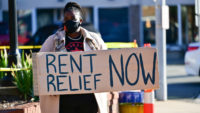David Adjaye and Others Tackle Social Issues in Opening Keynote of 2018 AIA Conference

Photo © Ed Schipul
When David Adjaye stepped onto the stage of Radio City Music Hall, to give the keynote address at the 2018 AIA conference last night, the audience might have been expecting calls to action. After all, the previous speakers had been adamant that architects must tackle social issues. Carl Elefante, the outgoing president of the AIA, admonished the crowd of 6,000 to “seize our dare-to-be-great moment,” a process, he said, that involves addressing the profession’s “diversity shortcomings.”
The subject of diversity was also taken up by Tamara Eagle Bull, FAIA, a member of the Oglala Lakota Nation and the first Native American woman in the U.S. to become a licensed architect. Eagle Bull, who owns Encompass Architects in Lincoln, Nebraska, was the winner of the AIA’s Whitney M. Young Jr. Award, named for the civil rights activist who at the 1968 AIA convention in Portland, Oregon, told the almost entirely white crowd that the profession was distinguished by its silence and irrelevance on issues of race. Fifty years later, Eagle Bull made the case for a profession that includes more Native Americans. “They are the only ones who can truly understand the needs of native communities,” she said, adding, “Diversity is good and diversity is necessary.”
Adjaye could have taken up the theme overtly, but he did so subtly, demonstrating that—in the words of Robert Ivy, the AIA’s executive vice president and chief executive officer, who introduced him—“his commitment to people, to communities, to social well-being are made real in every project that he does.”

Photo © Garagemca
Adjaye presented a series of buildings that address the needs of the disadvantaged. First up was a branch library in Washington’s neglected Anacostia section that he designed while his much larger National Museum of African American History and Culture (NMAAHC) was underway. Designing the Anacostia library allowed him to get to know the needs of a community, he said. He also showed Sugar Hill, a housing project in Harlem for the recently homeless, which he designed to be programmatically rich, with a children’s museum and a school at its base and a community garden on its roof. “The failure of 20th century New York was the ghettoization of poor communities,” he said, resulting in an “apartheid state.” The Sugar Hill project was meant to “work against that,” to find a way “in which the city can be generous for everyone. It’s something I feel very strongly about.” He added, “Homelessness, contrary to New York’s perception of itself, has actually been rising.”
The next project he showed, at 130 William Street in Lower Manhattan, is a 66-story condo building. Adjaye traced the origins of the tower’s arched windows to New York’s early warehouse buildings, with their load-bearing brick walls. Of course, he said, “we’re not making a brick load-bearing tower 66 stories high. Instead, he made its facades of panelized concrete, similar to those he used at Sugar Hill in Harlem. Inside are amenities like a basketball court and a cavelike spa overlooking the city.
Adjaye also showed renderings of his planned new building for the Studio Museum in Harlem, which he described as “the first museum in the country dedicated to supporting and incubating artists of the African diaspora.” He said his building captures the soaring architecture of Harlem’s churches and theaters, and makes references to the neighborhood’s vibrant street life.
Then, saving some of the best for last, he showed the NMAAHC, which he said “has been an extraordinary journey” and “has transformed my career.” He said that he set out to create a building whose shape recalls Yoruba art, so that the architecture wouldn’t “just be about trauma.” In closing, Adjaye asked poignantly, “Could we think of a world where maybe slavery hadn’t happened?”


